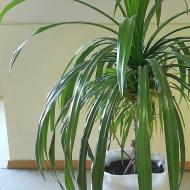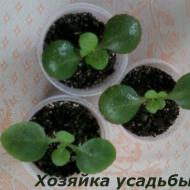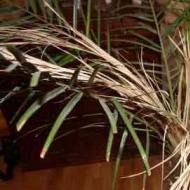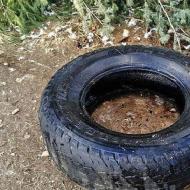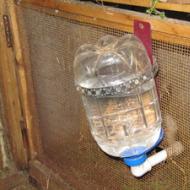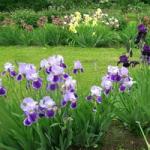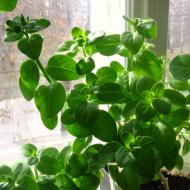
Pandanus care at home, watering, replanting and pruning. Pandanus - the original “screw palm” Lighting and air temperature
Pandanus, or Pandan, is a plant from the tropics, brought to us from the islands of the Indian Ocean. Resembles a palm tree with thin, spiral-shaped leaves. In an apartment, pandanus does not bloom or bear fruit, but this is fully compensated by the high decorativeness of the plant itself. Even a beginner in floriculture can organize pandanus care at home.
The genus consists of 600 species. Most representatives are tall tree-like plants. There are specimens of 15 meters or more. Sometimes they form voluminous shrubs. Despite the external resemblance, this is not a palm tree - pandanus has nothing to do with it.
Long aerial roots are released as a support and a means of obtaining moisture. An interesting sight is presented by plants with dead root parts of the trunk. They are held above the ground by aerial roots.
The shape of the leaves is xiphoid, the edges are sharp-serrate. They are attached to the stem in a spiral. The lower leaves gradually fall off, leaving scars on the stem. The barrel takes the shape of a screw. The flowers are small, yellowish, and form dense inflorescences.
As a houseplant, pandanus is more suitable for spacious apartments. It grows very quickly, tolerates dry air, and easily tolerates short-term lack of watering and low light.
Important! Pandanus leaves have a serrated edge and a central vein covered with spines. Use caution during transplantation. Wipe the leaves from the trunk to the top - in the direction of growth of the spines. It is not advisable to keep the flower in an apartment where there are small children - it is easy to get hurt on the sharp thorns.
Varieties for growing in an apartment
Of the 600 species that grow in nature, only a few are suitable for home cultivation. They are more compact in size - they do not grow above 3 meters.
- Pandanus Veitch. The trunk is shortened. Produces many aerial roots. The leaves grow spirally, close to each other. The length of the leaves is up to 80-90 cm. The color is intense, green. Light stripes run longitudinally. Characteristically, there are spines along the edge of the leaf. Compact variety - grows on average up to one and a half meters.


- Pandanus is useful. Higher view. Grows up to 2-3 meters. The leaves are straight, branched, and grow in a spiral. Color - rich green. Long - up to 1.5 meters. There are red thorns along the edge of the leaf.


- Pandanus Sandera. The trunk is shortened. Leaves up to 80 cm. Background - green, stripes - yellow. The edges of the leaves are covered with small spines.


Creating favorable conditions and care
Pandanus is unpretentious. Creating special conditions for its cultivation is not required. It responds to intensive care with rapid growth and high decorativeness.
- Lighting. Will grow anywhere - in sun or partial shade. Variegated species are not placed in the shade - the characteristic color becomes faded. When young, it is grown on a windowsill. Adult plants are placed in tubs on the floor, if possible, closer to the window. To avoid curvature of the trunk, the flower is regularly rotated around its axis.
- Temperature. Temperature range: 20-25°C. In winter, temperatures should not drop below 16°C. They try to avoid drafts.
- Humidity. Doesn't play a special role. Grows in both low and high humidity. It is not recommended to spray. Water accumulates in the sinuses, leading to rotting of the stem. For hygienic purposes, wipe the foliage with a damp sponge.
- Watering. A large mass of leaves requires increased watering. Water temperature - 30°C. In winter, the growth of pandanus stops - water less often. Frequency depends on temperature. The lower it is, the less often you water.
- Feeding. Any fertilizer for deciduous crops is suitable. Follow the dosage and concentration indicated in the instructions. Frequency: 2 times per month. It is not recommended to apply fertilizers to dry soil. Optimally - on the day of watering.
- Transfer. The root system is sensitive and vulnerable. Transplantation is resorted to in extreme cases; it is replaced by transshipment. Young specimens have to be transshipped annually due to rapid growth. Adults - if necessary, replace the potty. Aerial roots are left outside. The containers used are heavy, stable, and approximately the same width and height.
- The soil. Use nutrient soils with a high mineral content. Suitable soil mixtures for palm trees. The soil for adult plants should be dominated by turf soil.
Advice! Pandanus can be used not only for landscaping, but also for air purification. Its large leaves absorb harmful substances, release essential oils into the air and enrich it with oxygen. Essential oils have an antibacterial effect and destroy pathogenic microflora.
Reproduction methods
Seed and vegetative propagation of pandanus is practiced. It takes longer to grow from seeds, but over time it forms a full-fledged “palm tree”.
- Cuttings. Cuttings of 20 cm each are cut from long side branches. It is not recommended to use short cuttings - the process of root formation will be very slow. The sections are immediately treated with activated carbon powder. The substrate is made up of peat and sand. Take them in equal proportions. The cuttings are planted in separate containers under cover. Temperature for rapid rooting is 25-28°C. The greenhouse is periodically ventilated and the cuttings are watered with a root growth stimulator. Rooting takes 1.5-2 months.
- Sowing seeds. Seeds are sown without prior preparation. Keep under film at 25-27°C. Germination is quite fast - it takes about 10-15 days. The seedlings are watered regularly and the greenhouse is ventilated. The first pick is at the stage of three true leaves. Using bottom heating speeds up germination.
- Dividing the bush. Use daughter rosettes with a developed root system (20 cm). The rosette is cut from the main plant. If the roots are short, their growth is stimulated. Sphagnum moss is attached to the base of the rosette and moistened periodically. Planted in the spring. The cut rosettes are dried for 24 hours before planting. Planted in a separate pot. It is filled with alternating layers - drainage, base soil, river sand. The rosettes are planted and covered with film. The shelter is removed from mature plants. Bottom heating and maintaining the temperature at 25°C accelerates the rooting and adaptation of the young plant.
Important! Aerial roots should never be cut off. With their help, pandanus receives additional moisture from the air. At low humidity in the apartment, aerial roots do not form. This leads to loss of stability and the need to use supports.
Common problems and illnesses
It can be affected by all common indoor pests - spider mites, aphids, scale insects, mealybugs. If insects are detected, insecticide treatment is carried out. Severe violations of content recommendations can lead to a decrease in decorativeness.
Pandanus is of interest to beginners and experienced gardeners. The main advantages are unpretentiousness, high decorativeness, rapid growth, and the ability to purify the air.
The genus Pandanus belongs to the Pandanovae family, whose representatives are distributed mainly in the tropics of the Eastern Hemisphere. And the place where Pandanus itself appears is the Seychelles, Mauritius and Madagascar, from where these plants spread to other tropical zones.
Trees of these species grow in large mangrove groves on coasts and swamps. The large foliage of the plant is used by local residents in everyday life as material for roofs, boats, and carpets, due to which one of the species is called Pandanus roofing, which can also be grown as an indoor crop.
In some species, the fruits are edible and tropical residents use them as seasonings. But you don’t need to try the fruits yourself, since in some species they are poisonous. The remaining parts of the plant are not poisonous, but their leaves have sharp thorns that are dangerous for children; this must be taken into account when placing the plant in an apartment.
Pandanus species
At home, it can be quite problematic to determine the type of pandanus, since in many of them the main difference is the structure of the flower, and these trees do not bloom in the room.
Most often they grow to decorate our rooms. This evergreen beauty has a short shoot with hanging aerial roots, which over time become the main support of the tree as its lower part dies.
The foliage of this species is placed next to the leaf, pressed one to the other at the base, and can reach almost a meter in length. This species is variegated - the center of its leaves is green and the edges have white stripes. When grown indoors for a long time, it reaches one and a half meters in height.

Another species often grown by gardeners is one that has an impressive height. In the house this tree grows up to 2 meters, its foliage is very long, sometimes up to one and a half meters. Like other species, it does not bloom when grown at home.

Came to us from the Malay Islands. It has a low stem, the foliage is a little less than a meter long, its edges are covered with small thorns, and it is also variegated with yellow stripes.

Another type. The wild growth area mainly covers India. The name, as you might guess, comes from the strong and pleasant smell of orange flowers.

There are also low types of pandanus, which grow a little more than half a meter (, Sedge-shaped ).

Pandanus care at home
This exotic plant is native to the tropics and needs to be adapted to indoor conditions, but in general its cultivation is not difficult. When placing a tree indoors, it is better to select places that are well illuminated by diffused rays.
In winter, there should also be enough light, so it is better to place the container with the flower near the south window; if necessary, you can add additional lighting.
Turn the bush towards the light from time to time, otherwise it may begin to grow too much in one direction and fall over.
Summer temperature is not so important for this plant, and in winter it should not be allowed to drop below 17°C. Of all the species, only the Dwarf and Beneficial pandanus can survive short drops in the thermometer.
Read also about the Brighamia palm when caring for it at home by following the link.

Watering pandanus
Although in the wild pandanus grows in very humid conditions, when grown indoors its aerial roots are not so well developed and there is a risk of rot if there is excess moisture.
Because of this, when watering the plant, you need to ensure that the top ball of the earth dries out, but the soil as a whole does not dry out. To do this, one watering per week in the summer and one for 14 days in the winter will be enough. Water for irrigation should be used warm, soft, and settled.
These plants require high air humidity, so they need to be sprayed. This must be done with a spray bottle, so that the water does not remain in the axils of the foliage.

Fertilizer for pandanus
In spring and summer, the tree needs fertilizers. In order for pandanus to grow well, it will only need comprehensive feeding once every 15 days.
When the plant becomes an adult and large growth may begin to interfere, fertilizing can be reduced.

Pruning pandanus
Although this task is problematic because of the thorns, the foliage of the plant must sometimes be wiped with a damp cloth.
It is strongly not recommended to cut off children that appear abundantly near the trunk and aerial roots. But the drying edges of the foliage should be trimmed, but without touching the greenery.

Soil for pandanus
To plant the plant, you should choose light soil with weak acidity. To prepare it, mix clay and greenhouse soil, peat and sand in a ratio of 1:2:1:1.
When buying a ready-made substrate, it is better to pay attention to the soil for palm trees. It is also important not to forget about drainage, which is made from expanded clay.

Pandanus transplant
Pandanus grows quite quickly, and a few years after planting it has many aerial roots, which also enhances growth, and this in turn affects the frequency of replanting.
Young plants will have to be replanted approximately once a year; it is not worth carrying out this procedure more often, even if there is a desire. For adults, this process is applied once every three years. The most commonly used method is transshipment.
The new container is chosen to be slightly larger than the root. It is better not to take a tub that is too large, as the likelihood of soil acidification increases, which threatens rotting of the rhizomes.
If your tree is already very large and you want to limit its growth, stop replanting and simply change the top balls of the substrate in the tub. Transplanting an adult plant alone is problematic and is easier to do with two people.
If you need to leave, then do not be afraid for your pet. Pandanus will survive your absence without harm. Before leaving, you need to water it well and move the pot away from the window. If your absence will be quite long, then it is better to place the tub with the plant in a container with expanded clay, and also place the latter on top of the soil.

Reproduction of pandanus by shoots
Most often, to propagate pandanus, its children are rooted. The material on which small roots a couple of centimeters in size have already formed is cut off from the trunk. If necessary, it is possible to make the roots form faster; you just need to wrap the bottom or shoots with raw sphagnum. You can also immerse the shoots in water to stimulate the appearance of roots.
After being separated from the mother plant, the shoots are dried during the day and planted in light and nutritious soil, which can be made from sand and peat. After planting, the baby is covered with film to maintain high humidity and kept at a temperature of about 23°C, sprayed from time to time. Once rooted, the film is removed.
By carrying out this procedure in the spring, you can achieve good results.

Pandanus propagation by cuttings
Also, if your pandanus produces side shoots, it can be propagated by cuttings.
The material must be dried and the cut area must be powdered with activated carbon. The cuttings are planted in the same way as the children - in a mixture of sand and peat, covered with film.

Diseases and pests
Subject to proper care, pandanus causes almost no problems.
- If the air in the room is too dry or there is a lack of moisture in the soil, then it the leaves will dry out , starting from the ends.
- With aging the lower foliage will fall off on its own, but if it happens quickly, then most likely the problem is a lack of moisture.
- Small foliage and lack of growth , the absence of white stripes in variegated species indicates a lack of light.
- If, on the contrary, there is too much of it, then the foliage will turn pale and burns form on it. Also, whitening leaves may be a sign of watering with hard water.
- Yellowing of foliage indicates disturbances in the root system. This usually occurs due to rot, which appears when there is excess moisture, low temperature and drafts. Also, yellowing of the foliage can be caused by insufficient watering.
- Pandanus is almost never attacked by pests, and of those that may appear, they emit mealybug , spider mite And scale insect .
The tropical ornamental pandanus plant is quite easy to care for, but is not always suitable for home maintenance. However, the pandanus screw palm attracts attention and many will not deny themselves the pleasure of growing it.
Pandanus, also called "pandan", grows very quickly to quite impressive sizes, so the room in which the screw palm will be kept must be wide and with high ceilings. While the plant is young, it is often confused with indoor bromeliads, dracaena or yucca.
An extremely spectacular specimen from the Pandanaceae family, it is very easy to care for, patiently endures all hardships and hardships, and at the same time looks gorgeous.
The two most popular species are bred in indoor culture:
- Pandanus Sandera (pandanus sanderi) - a plant with a short trunk, on average reaching 1.5-2 m, the leaves are dark green, narrow, with yellow longitudinal stripes, finely spiny along the edges.
- Veitch's pandanus (pandanus veitchii) - leaves are leathery, green, with wide white longitudinal stripes and strong spines along the edges, arranged spirally along the trunk, tightly enveloping each other with their bases. It is not large in size, which makes it more compact and suitable for the room.

Photo: Pandanus Veitch with white longitudinal stripes along the leaf, reaches 1-1.5 m in height.
The leaves of an adult pandanus are very interesting and unusual; They are narrow and long, green, with or without stripes, leathery and shiny with sharp spines along the edges. The lower leaves fall off with age and the trunk becomes bare, leaving scars in their place, which is why the trunk appears spirally twisted and the magnificent pandanus takes on the appearance of a false palm.
Pandanus utilis - under the specific name “useful”, in a closed space reaches 2-3 m. Leaf plates with densely sharp spines of a reddish hue, arranged in a screw, hard, green, highly branched, directly directed, leaves reach 1.5 meters in length. In nature, a tree with a height of more than 20 m is found.
Pandanus leaves grow in a spiral, which is why this type of palm with spiny leaves is often called a spiral palm. Photos, description of types and features of care...

In the photo: a pandanus leaf with sharp thorns along the edges.
The screw palm has an interesting feature: it forms aerial roots on its trunk, which gradually grow and take root. At home, these are powerful stilted roots, which, growing into the ground, keep the plant raised above the soil surface. This is why the pandanus plant received the name “walking tree”.
In an apartment, these are small aerial roots that should not be removed. On hot days, you can strengthen sphagnum on these roots and moisten it regularly.
It doesn’t bloom in cultivation, at least I haven’t seen it. In nature it produces fruits that are similar to pineapples.
How to care for your pandanus
- Lighting.
It is this procedure that provides comfortable conditions for the normal functioning of the plant. The pot with the prickly palm is placed away from bright sunlight, but not in the shade. It is best to place the flower on the eastern side, where the pandanus can be exposed to the first rays of the rising sun. If the sun does not hit the leaves at all, they will lose their variegated color and simply turn green.
It is not difficult to care for a pandanus, the main thing is to provide it with a permanent place. If there is not enough light, you should use fluorescent lamps for at least 8 hours.

One of the main advantages of pandanus is considered to be the simplest care and conditions for keeping it at home.
- Temperature conditions.
The room temperature should not drop beyond +18 degrees, because pandanus is a heat-loving indoor plant. Tolerates heat well with regular spraying or wiping of leaves. In addition, dry air in the room causes the tips of the leaves to dry out. Protect the palm tree from drafts, otherwise it will immediately affect the leaves - they turn yellow and dry out.
- Watering and humidity.
Water the pandanus at the root, avoiding water getting into the axils of the leaves, and be sure to settle with warm water about once every week and a half. In spring and summer, it is recommended to increase watering.
If water gets into the axils of the leaves, it will have a detrimental effect on the entire plant and it will begin to rot. Therefore, a shower for a screw palm is contraindicated!
You can spray the leaves using a nozzle that sprays water as steam, and then only in extreme heat. The option of watering through a pan is possible, but after half an hour or an hour, the water from the pan should be poured out in order to prevent rotting of the roots.

- Feeding.
In the first half of spring, pandanus needs feeding. It is advisable to choose nitrogen-type fertilizer for foliage. It is better to immediately dilute it in water and water it on the top layer of soil, being careful not to get it on the plant itself, so as not to burn it.
Some fertilizers are sold in granules, so just mix them into the top layer of soil, where they will dissolve with each watering. However, to avoid the death of the plant, follow the dosage indicated on the package!
- Transfer.
Active growth requires periodic transplantation every 2-3 years. Only young plants are replanted, while for adults the top layer of soil is simply changed. The screw palm prefers a soil composed of leafy, turfy soil with the addition of sand and humus in equal parts.
If you decide to replant your home pandanus flower, do the replanting in the spring. To avoid damaging the leaves when planting, you need to tie the top in a bun or cover it with a bag.

Propagation of pandanus by cuttings
Some plant species reproduce by seeds, while others produce lateral shoots with air layering. Such cuttings need to be cut in the warm season, from April to July, until the pandanus enters a dormant period. Cuttings should be at least 10-20 cm long, since short shoots take root worse.

When propagating pandanus by cuttings, immediately plant the cut cuttings in moist soil and place the pot with them in partial shade. If desired, you can put a plastic bag or glass jar on the shoot - that is, create a mini-greenhouse, opening it slightly every day for two to three hours. At an air temperature of 25C, root germination will occur in about a month.
When planting seeds in the ground, do not clear them of inflorescences and adhere to the same temperature conditions, creating a mini-greenhouse.
For any visible disturbances in the cultivation and growth of pandanus, pay attention to the factors surrounding it:
The leaves have lost their variegated color - lack of sunlight;
The leaves, on the contrary, have become whitish and light - it is worth removing the pot from the window;
Dry tips will indicate dry air in the room or a lack of moisture in the soil.
Caring for a pandanus at home will not be difficult if you place it correctly.
It is best to raise the plant in your home to a height and tie the leaves to prevent damage to the skin of children or animals. The ideal place for growing pandanus will be workrooms, offices, conference rooms, winter gardens where it will be provided with a lot of space and no one will touch it - ...
Pandanus is an extremely interesting plant. It is very easy to grow, you just need to follow simple rules. True, some gardeners are frightened by the gigantic size of an adult plant. But anyone who can allocate a spacious and warm corner in their living space for the development of pandanus will not regret it.
Description of pandanus
Pandanus or pandan is an amazing plant. In nature, its size causes admiration. Some species have edible fruits. Inflorescences, roots, leaves are an integral part of traditional medicine and are even used in magical rituals. The strong leaf veins are used as weaving material.

Pandanus is an amazing plant that locals use everywhere
The tropics of the Eastern Hemisphere are the native land of the plant. There are about 750 species of pandanus in nature. On the island of Madagascar alone you can find almost 90 representatives of this species. The first description of pandanus was made by the French botanist and traveler Jean-Baptiste Bory de Saint-Vincent. The original name, pandan, comes from the Indonesian name for the plant.
Pandanus grow in coastal areas, on sandy and rocky soil. They can be found in dry, mountain and alpine forests, along the edges of volcanic craters and on their slopes. Coral reefs are also overgrown with these amazing plants.

Pandanuses grow in different places, but are more common in the coastal zone
Pandanus is often called a palm tree, more precisely a screw palm or even a pine tree. It is somewhat similar to dracaena. But pandanus has nothing in common with these plants.
The plant belongs to the genus of tree-like evergreen plants of the Pandanaceae family. Sometimes it develops in the form of a bush. Pandanus is a powerful tree, the height of its trunk reaches 15 m, and often reaches a height of 25 m. But at home, its dimensions are much more modest - only 1.5 m. Young specimens do not grow very quickly. Mature plants grow leaves more intensively.
Video: pandanus in its natural habitat
The trunk is formed as old leaves lose their life. Its surface, with traces of leaves growing in a spiral, resembles a screw (hence the name - screw palm). The trunk can branch like a dracaena. Another interesting feature of pandanus is its roots. The adventitious or stilt roots extending from the trunk are an excellent anchor that holds the tree in place during strong winds and hurricanes. There are times when the trunk of a plant dies, and then the support of the pandanus becomes aerial roots that have grown into the ground and become woody.

Powerful aerial or stilted roots help pandanus stay in place during strong winds
The leaves are narrow and long, linear in shape. The length sometimes reaches 3–4 m, width - 10–15 cm. They are located on the trunk in the form of a spiral, in 2–4 rows. The leaf blade is rigid, strewn with sharp teeth along the edge, and is very reminiscent of a pineapple leaf.

The narrow and long leaves of pandanus, with thorns along the edges, resemble pineapple leaves
Flowers are unisexual. The male ones are collected in inflorescences similar to spikelets. Female - resemble a cob or cone. The fruits are red, fleshy. Somewhat reminiscent of pineapple.

Pandanus flowers are unisexual
Growing pandanus at home is not difficult. You just need to take into account some of its features and follow simple conditions of detention. Pandanus is an ideal option for those who love fast-growing but unpretentious plants. It is also suitable for beginner flower growers, as it is ready to put up with some mistakes. The only drawback is that it requires a lot of space and in small rooms an adult plant will be cramped. The ease of care and the beauty of the leaves, similar to green fountains, made this plant an ideal option for decorating winter gardens, spacious halls, hotel and restaurant interiors. At home and in countries with warm climates, pandanus is used in landscape design.
Video: pandanus or screw palm
If there is a child in the house, then you need to explain to him that pandanus leaves are prickly and should not be touched with your hands.

The only drawback of pandanus is that it needs a lot of space for normal development.
Types and varieties grown indoors
Of the huge variety of pandanus, only a few species can be found at home.
| Types and varieties | Description |
| Evergreen perennial, 1.5 m high. Branches from a shortened trunk adventitious roots. The leaf is narrow, serrated along the edge. Length - 90 cm, width – up to 8 cm. Leaves are leathery, green. It doesn't bloom in the room. Dense Local residents use the leaves as material for house roofs. Also from This type of hats, baskets, rope and even sails are made for small boats. |
|
| One of the most common in indoor floriculture. Refers to variegated or variegated species. The height of the plant sometimes reaches 2 m. The leaf is 60–90 cm long and strewn with sharp thorns along the edge. Trunk short, aerial roots extend from it. Dark green surface the leaf plate along the edges is decorated with longitudinal stripes of white or yellowish in color. |
|
| This plant has a more modest size. Sheet length 80 cm, width – 5 cm. The edges of the leaf plate are green with a yellow stripe along the central vein is strewn with small teeth. |
|
| The room reaches 2 - 3 m in height. Stiff leaves are strewn along the edges sharp spines of a reddish hue and are located on the stem helical. The length of the leaf plate reaches 1.5 m. |
|
| The height of the plant is 2 m. The decoration is a lush cap of narrow leaves. They are leathery to the touch. The green leaf plate is decorated with yellow stripes. Has smooth leaf edges. |
Photo gallery: domesticated pandanus species
Pandanus roofing is used as a material for roofs Pandanus Veitcha is the most common in indoor floriculture The leaves of pandanus Sander are decorated with a yellow stripe located in the center The edges of the leaves of pandanus useful are strewn with red spines Pandanus Baptista has smooth leaf edges
Even such an undemanding plant as pandanus will be pleased if the grower creates conditions for it that are similar to natural ones.
Table: seasonal conditions of detention
| Season | Lighting | Temperature | Humidity |
| Spring | Different people's requirements for light The species are slightly different. Plants prefer with stripes on leaves bright but diffused light. To avoid burns from high solar activity pandanus should be protected, hidden behind the lungs curtain. Green-colored species leaf blades are more shade-tolerant. They can even grow in the back of a room. The most suitable direction for pandanus lighting - eastern or southeast windows. In the north direction even in summer, there will be lighting lack. For uniform development leaf mass of the plant, it should be sometimes turn towards the light source the opposite side. |
Accustomed to warm climates pandanus and at home prefers stable heat without sharp temperature fluctuations. Confident enough flower develops at indicators thermometer 20 – 22 0 C. Although calm will survive even 28 0 C heat. |
Pandanus tolerates dry conditions very well. air, but keep it at low constant humidity is destructive. In summer the plant is needed periodically spray and wipe leaves damp dust cloth (when caring for leaves, be sure to Protect your hands by wearing gloves.) Showering is still not recommended, so like water accumulating in the sinuses leaves may cause rotting. Optimal humidity should be approximately 60%. |
| Summer | |||
| Autumn | In winter it is better to place a flower near south window. Due to the large size Pandanus cannot always be placed on a window, therefore, in short daylight conditions need to use additional backlight. |
Minimum temperature threshold, permissible in winter - 18 0 C, when it decreases in the plant may have problems. From all types only Dwarf and The useful may not endure for long low temperatures up to 12 0 C. |
In winter, the plant must be maintained away from heating appliances. To support required humidity level around the plant, it is worth putting pot on a tray with moistened expanded clay. The main thing that the drainage holes did not touch water. |
| Winter |

Pandanus prefers bright but diffused light
On many sites you can find information that pandanus and the street are incompatible things. You can take pandanus outside in the summer, but under certain conditions. The temperature should be consistently warm, without sudden drops at night. The plant will do well on a glassed-in balcony. You can enjoy fresh air during the day, and close the window at night so that the drop in temperature does not harm the plant. And yet, in such a secluded corner, wind and drafts will not be scary.
Pandanus and florarium
Due to its large size, pandanus is not suitable for growing in florariums. Even if it is placed there, the plant will experience difficulties, since it needs space for full growth. Grown in an unlimited space, pandanus looks great as a single plant or surrounded by other green fellows.

To reveal its potential, pandanus needs unlimited space.
Planting and transplanting
For normal development, a young pandanus needs an annual change of pot for 5 years. Moreover, the new pot should not be large in size; it is permissible to exceed the previous one by only 2 or 3 cm. The bottom should have holes to remove excess moisture. Young specimens can be planted in plastic containers. For large plants you need to choose a stable pot. When purchasing a pot, do not forget to buy medium-sized drainage. For large containers it is better to use a large fraction.
Adult pandanuses are replanted no more than once every 3 years. The new container should be approximately 1/3 higher than the previous one. The width of the pot is standard. The apparent power of aerial roots is actually very deceptive. They are very fragile, so transplantation is carried out exclusively by transferring the plant from one container to another. Removing such roots is strictly prohibited. To prevent them from drying out, you can use wet moss wraps.

The aerial roots of pandanus are very fragile, so you need to be extremely careful when replanting.
Potted plants are not replanted at all. For them, it will be enough to replace the top layer of soil in the tub with a more nutritious one. This is done once a year or 2 times. When the pandanus is prepared for transplanting into a tub, not 1, but 3 parts of turf soil are added to the prepared earthen substrate so that the plant has enough nutrients for a long time.
To curb the growth of pandanus, replanting is carried out less frequently, only replacing the top layer of soil, just like in tub specimens.
The soil for pandanus needs to be nutritious and loose, but containing a small amount of clay. You can use commercial palm substrate. Those who like to make soil mixtures with their own hands need to mix the following components in equal parts:
- greenhouse soil - 2 parts;
- clay soil - 1 part;
- peat - 1 part;
- coarse sand - 1 part.
Or this option - turf and leaf soil, river sand and humus. The components are taken in equal parts.

When preparing the soil, mix all ingredients well
Soil acidity also matters. A suitable pH is around 6.
Step-by-step transplant process

Pandanus purchased in a store cannot be replanted immediately. The plant must be given time to adapt - about 10 days.
Does pandanus need support?
In general, pandanus does not need support. But there are situations when the flower begins to grow one-sidedly. This happens with overgrown and not transplanted plants in time, moreover, located in a room with dry air. Under such conditions, aerial roots stop growing and cannot further support the flower. If you can’t replant, then place a support next to the pandanus - a strong bamboo stick will do.

There are situations in which a pandanus cannot survive without support.
Care
Even such an indestructible plant, as it is jokingly called, like pandanus, needs proper care. It is very easy and will not be difficult.
Watering and effective fertilizing
Although pandanus grows on coasts where frequent flooding occurs, it does not tolerate excessively moist soil when grown indoors. Moreover, if the pot, as they say, is about to grow and the soil is heavy and does not conduct water well. The top layer of soil must dry out before the plant is watered again.
In summer, water the plant abundantly and be sure to remove any remaining water from the pan. In winter, you need to be more careful when moistening, especially if the pandanus is in a cool room. After the top layer has dried, you need to wait another 2–3 days before watering.
Watering should be sufficient so that the moisture wets the entire earthen ball, and not the surface, leaving the roots dry.

You need to water the pandanus abundantly so that the moisture moistens the entire earthen ball.
Under standard conditions, in summer the frequency of watering is once a week, in winter - once every 2 weeks. But this is all conditional. You need to rely on the specifics of your conditions of detention. The hotter it is, the more often you will water, and vice versa.
In addition to waterlogging, prolonged drying out of the soil is also extremely undesirable for pandanus. Dried and yellowed leaves will not decorate the plant, but, on the contrary, will ruin the entire impression.
The irrigation liquid should settle and be at room temperature. If wetted with cold water, the plant may become stressed and stop growing. It is very good to water with melt or rain water. An excellent effect is achieved by bottom watering, in which the liquid should have a temperature of 35 0 C.
Liquid mineral fertilizers of universal purpose are used as fertilizing. Feeding in the spring-summer period occurs 2 times a month. In winter it is reduced to 1 time per month.
The transplanted plant begins to be fertilized only after a month or a month and a half. All this time, the pandanus will make do with the nutrients available in the soil.

Any universal fertilizer is suitable for pandanus.
In order to control growth, fertilizing is reduced to a minimum or stopped altogether. Without nutrition, pandanus growth slows down greatly.
Flowering period
This amazing plant blooms only in the wild. When grown indoors, flowering does not occur. But from time to time there are statements that, although rarely, the plant produces flower stalks at home.
Rest period
The plant does not have a pronounced dormant period. But in winter, pandanus practically stops growing. Feeding and watering at this time are carried out rarely and carefully. The temperature can be lowered slightly so that the plant can rest fully, because growth will continue in a warm room.
But what really wouldn’t hurt is additional lighting. From autumn to spring, daylight for pandanus should last at least 8 to 10 hours. Therefore, the plant must be illuminated for up to 6 hours a day. To do this, install a fluorescent lamp at a distance of a meter from the flower.

In winter, pandanus needs to be illuminated
crown formation
There is no need to specially form the crown of pandanus, since the plant has an apical growth type. In an adult plant, the trunk forms on its own as the lower leaves fall off. Only single-stem species are grown indoors.

In nature, as well as when grown at home, pandanus itself forms a trunk
Sometimes the trunk becomes overgrown with numerous children. Many gardeners leave them so that the lower bare part of the plant looks more luxuriant. But this is a matter of taste. You can root these shoots and get new plants.
To give the pandanus an aesthetic appearance, you need to periodically trim off the dry ends (if any). Trimming is done so that a small area of dead tissue remains, which will prevent further drying.
How care errors manifest themselves and what to do to correct the situation
As already noted, pandanus is very unpretentious. To grow a flower at home, you do not need to create any special conditions for it. But the inexperience of the grower can be the reason why the plant suddenly stops growing or its leaves begin to turn yellow. To correct the situation, you need to understand the error in time and eliminate it.
Table: care errors and their elimination
| Manifestation | Cause | Elimination |
| The tips of the leaves become dry and brown |
|
heating appliances. Pandanus leaves
I'm thirsty. Water properly. |
| Leaves lose color become almost white |
|
but its excess negatively affects the color
water for at least 24 hours. |
| Young leaves growing small, bright stripes they turn pale, turn green |
Not enough light | Variegated pandanus species require a little more light than plain ones. But you should still shade it from direct sun. |
| Leaves turn yellow |
|
not enough.
|
| Light necrotic spots on leaves |
Sunburn. | Shade the plant from direct sun, especially in the summer. |
| The leaves grow small and yellow |
Lack of nutrients. | Don't forget that for growth Pandanus definitely needs feeding. |
| The lower leaves dry out and disappear |
Natural aging process. | Over time, the lower leaves fall off, forming false palm trunk. This process is based by nature itself. Therefore, if at the same time young the leaves grow healthy, then there is no need to worry. |
Photo gallery: typical mistakes made when growing pandanus
Dry and brown tips of the leaves are evidence of insufficient watering and low air humidity. Excessive lighting causes pandanus leaves to become light, almost white. Necrotic spots on the leaves are the result of sunburn
Diseases and pests
Pests and diseases are extremely rare on this hardy plant. But, I repeat, improper care can become the catalyst that provokes both fungal diseases and the appearance of pests.
Table: diseases and pests of pandanus, control measures and prevention
|
Diseases and pests |
Symptoms and manifestation |
Control measures | Prevention |
| Leaf spot | Fungal infection affects leaves. They appear spots of different colors that have round or oval shape. At high humidity the leaves fade. |
Spray with one of the fungicides -
3 or 4 times. |
loose, well permeable
keep under control to
waiting for the top to dry |
| Root rot and stem |
Most common disease caused excessive watering and cold air. Leaves first turn yellow and lethargic. Then they get dark. On roots and trunk appear rotten areas. The plant may quickly wither. |
damaged areas of roots.
Cuprosan or Chometsin on
with disinfected
fungicide. |
|
| Shchitovka | Leaves turn brown bumpy and sticky secretions. Hiding under pests actively suck on their shield juice from leaves. As a result the leaf dries out and curls. |
the following drugs are used:
processing is carried out 2 – 3 times |
got rid of recently
tincture of onion or garlic.
allow it to increase or decrease.
in which pandanus grows. |
| Mealybug | Appeared in the leaf axils cotton wool coating? This indicates defeat mealybug. The leaves turn yellow, fall off, growth stops. The plant is weakening. |
||
| The most common pest appearing if the air is very dry. ABOUT his presence is evidenced thin web. Pest sucks juices from leaves through small punctures, which manifest themselves in in the form of small dots. Leaves Mealybug weakens the plant Spider mites cause leaves to dry out Reproduction methods at homeDespite the simplicity of growing pandanus itself, its reproduction can cause some complications. But if everything is done correctly, there should be no problems. The time suitable for rooting is mid-spring. Rooting daughter rosettesThe trunk of an adult pandanus is very often overgrown with daughter rosettes. Beginning flower growers sometimes rush and tear off the children from the mother plant when they have not yet acquired roots. This cannot be done. Without roots, the rooting process can turn into a complete failure. For the process to proceed without losses, you need to wait until the rosettes grow to 20 cm in height and they have their own root system. To stimulate the root formation process, you can wrap the root buds with moss, regularly moistening it with a spray bottle. Germination of seeds |




